Abstract
Despite scientific advancement made in poultry farming, the problem of fowl typhoid is still persistent, discouraging significantly the economic prospects of poultry industry. New vaccines and vaccination approaches could make cost effective differences in control of such unbridled infection. Mucosal vaccination in the reproductive tract can stimulate protective localized innate immune response against fowl typhoid. The objective of the study was to investigate induction and dynamics of lysozyme activity within reproductive tract and systemic) circulation following experimental infection with Salmonella Gallinarum at various phases of egg laying viz., pre-egg laying (17–18 weeks), onset of egg-laying phase (19–20 weeks), and peak egg-laying phase (23–24 weeks). Chickens were either infected via intravenous or intravaginal route with107 CFU−1 ml of Salmonella Gallinarum. Lysozyme activity was assessed by turbidimetric method employing suspension of Micrococcus lysodeikticus. Lysozyme activity increased during egg-laying phases (both at onset and peak egg-laying phase) and was high in reproductive wash following infection. Serum lysozyme activity was not significantly different between intravenously and intravaginally infected birds. Day 7 post-infection in each trial appeared to be crucial point for intravenously infected birds, where lysozyme activity in both the bodily secretions reduced to their lowest level.The maximum activity was noted during onset of egg laying with pronounced levels in intravaginal inoculates. Immune elicitation in reproductive tract is possible and can be enhanced by injecting suitable antigen amidst different egg-laying phases including S. Gallinarum infections.


Similar content being viewed by others
Availability of data and material
Can be made available on request to the corresponding author.
References
Anikethana R, Deshmukh S, Pathak D, Banga HS (2019) Assessment of Salmonella Gallinarum colonization in chicken’s oviduct and its consequent cellular immune response at various stages of egg laying. Paper presented at XXIst World Veterinary Poultry Association Congress held at BITEC, Bangkok, Thailand from 16-20, 2019, pp-21
Barr EL, Parr MB (1985) Secretory immunoglobulin binding to bacteria in the mouse uterus after mating. J Reprod Immunol 8(1):71–82
Berchieri A Jr, Murphy CK, Marston K, Barrow PA (2001) Observations on the persistence and vertical transmission of Salmonella enterica serovars Pullorum and Gallinarum in chickens: effect of bacterial and host genetic background. Avian Pathol 30(3):221–231
Ellis AI (1990) Lysozyme assay. In: Stolen JS (ed) Techniques in fish immunology, 1st edn. SOS Publication, Fair Haven, NJ, pp 101–103
Fearon DT, Locksley RM (1996) The instructive role of innate immunity in the acquired immune response. Science 272(5258):50–54
Fletcher TC, White A (1973) Lysozyme activity in the plaice (Pleuronectesplatessa L.). Experientia 29(10):1283–1285
Harikrishnan R, Balasundram C, Man-Chul K, Ju-Sang K, Yong-Jae H, Moon-Soo H (2010) Effect of a mixed herb-enriched diet on the innate immune response and disesae resistance of Paralichthys olivaceaus against Lymphocystis disesae virus. Fish Shellfish Immunol 29:668–673
Jee JH, Masroor F, Kang JC (2005) Responses of cypermethrin-induced stress in haematological parameters of Korean rockfish, Sebastes schlegeli (Hilgendorf). Aquac Res 36(9):898–905
Knopf HL, Blacklow NR, Glassman MI, Cline WL, Wong VG (1971) Antibody in tears following intranasal vaccination with inactivated virus. II. Enhancement of tear antibody production by the use of polyinosinic: polycytidilic acid (poly I: C). Invest Ophthalmol 10(10):750–759
Koinarski V, Sotirov LK, Denev S (2012) Serum lysozyme concentrations in broilers treated with Sel-Plex® and sodium selenite and infected with Eimeria tenella. Turk J Vet Anim Sci 36(4):433–437
Ling YS, Guo YJ, Li JD, Yang LK, Luo YX, Yu SX, Zhen LQ, Qui SB, Zhu SF (1998) Serum and egg yolk antibody titres from laying hens vaccinated with Pasteurella multocida. Avian Dis 42:186–189
Liu D, Guo Y, Wang Z, Yuan J (2010) Exogenous lysozyme influences Clostridium perfringens colonization and intestinal barrier function in broiler chickens. Avian Pathol 39(1):17–24
Parry RM Jr, Chandan RC, Shahani KM (1965) A rapid and sensitive assay of muramidase. Proc Soc Exp Biol and Med 119(2):384–386
Prabakaran M, Binuramesh C, Steinhagen D, Michael RD (2006) Immune response and disease resistance of Oreochromis mossambicus to Aeromonas hydrophila after exposure to hexavalent chromium. Dis Aquat Org 68(3):189–196
Ragland SA, Criss AK (2017) From bacterial killing to immune modulation: recent insights into the functions of lysozyme. PLoS Pathog 13(9):e1006512
Ronen D, Eylan E, Romano A, Stein R, Modan M (1975) A spectrophotometric method for quantitative determination of lysozyme in human tears: description and evaluation of the method and screening of 60 healthy subjects. Invest Ophthalmol vis Sci 14(6):479–484
Saurabh S, Sahoo PK (2008) Lysozyme: an important defence molecule of fish innate immune system. Aquac Res 39(3):223–239
Shivaprasad HL (2000) Fowl typhoid and Pullorum disease. Rev Sci Tech (international Office of Epizootics) 19(2):405–424
Silphaduang U, Hincke Maxwell T, Nys Y, Mine Y (2006) Antimicrobial peptides in chicken reproductive system. Biochem Biophys Res Commun 340(2):648–655
Studnicka M, Siwicki A, Ryka B (1986) Lysozyme level in carp (Cyprinus carpio L.). Bamidgeh 38(1):22–25
Tahir A, Secombes CJ (1995) The effects of diesel oil-based drilling mud extracts on immune responses of rainbow trout. Arch Environl Contam Toxicol 29(1):27–32
Wang Z, Zhang S (2010) The role of lysozyme and complement in the antibacterial activity of zebra fish (Danio rerio) egg cytosol. Fish Shellfish Immunol 29(5):773–777
Wigley P, Berchieri A Jr, Page KL, Smith AL, Barrow PA (2001) Salmonella enterica serovar Pullorum persists in splenic macrophages and in the reproductive tract during persistent, disease-free carriage in chickens. Infect Immun 69(12):7873–7879
Withanage GS, Baba E, Sasai K, Fukata T, Kuwamura M, Miyamoto T, Arakawa A (1997) Localization and enumeration of T and B lymphocytes in the reproductive tract of laying hens. Poult Sci 76(5):671–676
Withanage GS, Sasai K, Fukata T, Miyamoto T, Baba E (1998) Secretions of Salmonella specific antibodies in the oviducts of hens experimentally infected with Salmonella Enteritidis. Vet Immunol Immunopathol 67:185–193
Yildiz HY (2006) Plasma lysozyme levels and secondary stress response in rainbow trout, Oncorhynchus mykiss (Walbaum) after exposure to Leteux-Meyer mixture. Turkish J Vet Anim Sci 30(2):265–269
Acknowledgements
Tha authors sincerely acknowledge the financial support received from the Department of Biotechnology, Government of India, File No: BT/PR15613/ADV/90/196/2015.
Funding
This study was supported by the financial grant received from the Department of Biotechnology, Government of India, File No: BT/PR15613/ADV/90/196/2015.
Author information
Authors and Affiliations
Contributions
HS collected samples and performed lysozyme assay. SD: design the experimental plan and performed experiment, drafted manuscript. PK: performed lysozyme analysis and partial drafting of manuscript. HSB: performed lysozyme analysis and review the manuscript.
Corresponding author
Ethics declarations
Ethics approval
Animal experimentation approval was obtained from local institutional animal ethics committee (IAEC, GADVASU, Ludhiana). The experiment was performed as per the guidelines laid down by the institutional animal ethics committee.
Consent to participate
Not applicable.
Consent for publication
All authors agreed to the content of the article and prior consent was obtained from each authors for submission.
Conflict of interest
The authors declare no competing interests.
Additional information
Publisher's Note
Springer Nature remains neutral with regard to jurisdictional claims in published maps and institutional affiliations.
Rights and permissions
About this article
Cite this article
Sethi, H., Deshmukh, S., Kaur, P. et al. Reproductive and systemic lysozyme activities in chicken during experimental Salmonella Gallinarum infection: a comparative analysis between various egg-laying phases. Comp Clin Pathol 31, 391–396 (2022). https://doi.org/10.1007/s00580-022-03338-0
Received:
Accepted:
Published:
Issue Date:
DOI: https://doi.org/10.1007/s00580-022-03338-0




